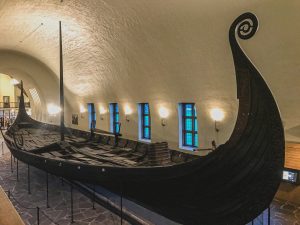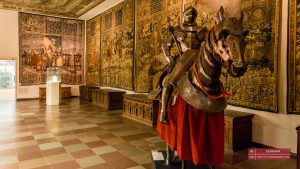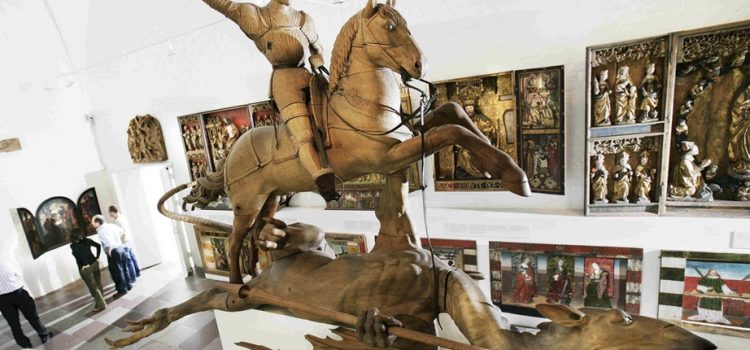
Denmark, a land of rich history and stunning landscapes, offers a fascinating journey through time with its array of historical sites. From Viking ruins to royal castles, Denmark’s heritage is a testament to its vibrant past. Join us as we explore some of the most must-visit historical sites in Denmark.
Kronborg Castle
Kronborg Castle, famously known as Elsinore in William Shakespeare’s “Hamlet,” is one of the most significant Renaissance castles in Northern Europe. Located at the narrowest point of the Oresund Sound, this UNESCO World Heritage Site boasts a rich history dating back to the 1420s. Visitors can wander through the grand halls, explore the Royal Apartments, and delve into the castle’s dark dungeons. The castle also hosts the annual Shakespeare Festival, where you can experience performances in an authentic setting.
Viking Ship Museum
Located in Roskilde, the Viking Ship Museum offers an unparalleled look into Denmark’s Viking heritage. The museum houses five original Viking ships recovered from Roskilde Fjord, providing insight into the seafaring capabilities of these ancient warriors.
Interactive exhibits and reconstructed ships offer a hands-on experience, allowing visitors to sail in Viking-style vessels. The museum’s extensive research and preservation efforts make it a crucial center for Viking studies globally.

Jelling Stones
The Jelling Stones, often referred to as Denmark’s birth certificate, are two massive rune stones erected by Viking King Gorm the Old and his son Harald Bluetooth. These stones mark the transition from paganism to Christianity in Denmark around the 10th century.
This UNESCO World Heritage Site includes a museum that provides in-depth information about the Viking Age and the significance of the stones. The nearby Jelling Church and burial mounds further enrich the historical context.
Frederiksborg Castle
Frederiksborg Castle, situated in Hillerud, is the largest Renaissance castle in Scandinavia. Built in the early 17th century by King Christian IV, the castle is surrounded by a beautiful baroque garden and a scenic lake.
The castle now houses the Museum of National History, featuring extensive collections of portraits, historical paintings, and modern art. The Chapel of Orders and the Great Hall are particularly noteworthy for their opulent decorations and historical significance.
Aarhus Old Town
Aarhus Old Town, or Den Gamel By, is an open-air museum in Aarhus that offers a unique walk-through Danish history. The museum consists of 75 historical buildings relocated from various parts of Denmark, representing the urban history of the country from the 16th century to the 1970s.
Visitors can explore period-accurate homes, shops, and workshops, interact with costumed interpreters, and experience everyday life from different historical periods. Special exhibitions and events provide deeper insights into Denmark’s cultural evolution.
Royal Burial Church
Roskilde Cathedral, a UNESCO World Heritage Site, is the burial site for Danish monarchs and a masterpiece of Gothic architecture. The cathedral’s construction began in the 12th century and has been the primary burial site for Danish royalty since the 15th century. Offering a unique cultural experience. Denmark’s rich history is a treasure trove waiting to be discovered by historical travel enthusiasts. From the Viking Age relics in Roskilde to the Renaissance splendor of Frederiksborg Castle The interior of the cathedral is adorned with royal tombs, intricate frescoes, and stunning stained-glass windows. The adjoining museum offers detailed information about the cathedral’s history and its significance in Danish heritage.
Egeskov Castle
Egeskov Castle, located on the island of Funen, is one of Europe’s best-preserved Renaissance water castles. Built in 1554, the castle is surrounded by picturesque gardens, mazes, and a moat, creating a fairytale-like atmosphere. The castle’s interior is equally enchanting, featuring antique furniture, historical exhibits, and a fascinating collection of vintage cars and motorcycles. The surrounding park offers numerous attractions, including treetop walkways and playgrounds, making it a perfect destination for families.
National Museum of Denmark
The National Museum of Denmark in Copenhagen is the country’s largest museum of cultural history. Its extensive collections span from the Stone Age to the modern era, offering a comprehensive overview of Denmark’s history and cultural heritage. Highlights include the prehistoric Sun Chariot, the Gundestrup Cauldron, and the Egtved Girl’s grave. The museum’s interactive exhibits and educational programs make it an engaging experience for visitors of all ages.

Round Tower
The Round Tower (Runde Tarn) in Copenhagen, built in the 17th century by King Christian IV, is the oldest functioning observatory in Europe. This architectural marvel offers a panoramic view of Copenhagen from its unique spiral ramp leading to the top. The tower also hosts exhibitions, concerts, and events throughout the year, providing a blend of historical and cultural experiences. The adjoining Trinitatis Church adds to the site’s historical charm.
Denmark’s Oldest Town
Ribe, founded in the early 8th century, is Denmark’s oldest town and a gem of medieval history. Its well-preserved old town features cobblestone streets, half-timbered houses, and the majestic Ribe Cathedral. The Ribe Viking Center offers an immersive experience of Viking life, with reconstructed buildings, crafts, and activities. The town’s rich history is further showcased in the Ribe Art Museum and the Wadden Sea Centre, highlighting the natural and cultural heritage of the region.
Conclusion
Denmark’s historical sites offer a captivating journey through time, from the Viking Age to the Renaissance and beyond. Each site provides a unique glimpse into the country’s rich heritage and cultural evolution. Whether you’re a history enthusiast, a culture lover, or simply a curious traveler, Denmark’s historical landmarks are sure to leave a lasting impression.










